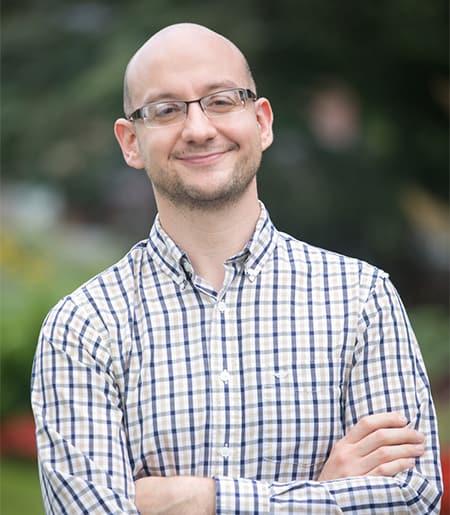Overview
My lab studies high brightness electron beams. We focus on the physics of beam creation and brightness preservation in linear and circular accelerators, for applications ranging from time resolved electron diffraction to high brightness synchrotron radiation sources. In practice, our work combines the use of detailed beam simulations with the design, construction, and operation of accelerator hardware with high resolution beam diagnostics.
Research Focus
A “bright” electron beam is one that is both dense and collimated, and in modern accelerators, brightness is an excellent figure of merit for an electron beam’s usefulness. This is true of both tabletop accelerators like electron microscopes as well as kilometer-scale accelerators like colliders or free electron lasers. While these machines are very different, common threads of brightness-limiting phenomena emerge among them: the brightness of the particle source, the beam’s collective self-interaction and induced nonlinear dynamics. Our group studies these effects in multiple accelerators on Cornell’s campus.
In particular, one significant effort within my group is to grow and characterize high brightness electron photoemitting materials. In any linear accelerator, the beam’s brightness is fundamentally limited by the intrinsic momentum spread of the photoemission which generates the beam. The pursuit of “cold” (low divergence) photoemitters has the potential to dramatically improve the performance of a wide array of future linear accelerators. Our group uses molecular beam epitaxy (MBE) techniques to grow atomically-ordered photoemitting materials like alkali antimonides, and to characterize them in our in-house test accelerators.
We also seek to deploy high brightness photoemitters in accelerator applications both locally and across the accelerator community. On Cornell's campus, we've developed a new ultrafast electron diffraction device based on our in-house-grown photoemitters that produces high quality diffraction images of materials with sub-picosecond resolution, allowing us to observe atomic motion in atomic-real-time. We collaborate with condensed matter physics groups in this effort. Our team seeks to explore exotic phases in quantum materials that arise transiently on ultrafast timescales, and in particular, phases which are otherwise unavailable in static equilibrium.
Our group works closely with the Center for Bright Beams, an NSF science and technology center led by Cornell.
Graduate Students
Michael Kaemingk, Chad Pennington, Charles Zhang, Benjamin Dickensheets
Professional Experience
- Postdoctoral Scholar, University of California Los Angeles, 2015-2017.
- Assistant Professor, Cornell University, 2017-present.
Publications
C.T. Parzyck, A. Galdi, J.K. Nangoi, W.J.I. DeBenedetti, J. Balajka, B.D. Faeth, H. Paik, C. Hu, T.A. Arias, M.A. Hines, D.G. Schlom, K.M. Shen, J.M. Maxson, "Single-Crystal Alkali Antimonide Photocathodes: High Efficiency in the Ultrathin Limit," Physical Review Letters 128 (11), 114801 (2022).
W.H. Li, C.J.R. Duncan, M.B. Andorf, A.C. Bartnik, E. Bianco, L. Cultrera, A. Galdi, M. Gordon, M. Kaemingk, C.A. Pennington, L.F. Kourkoutis, I.V. Bazarov, J.M. Maxson, "A kiloelectron-volt ultrafast electron micro-diffraction apparatus using low emittance semiconductor photocathodes," Structural Dynamics 9 (2), 024302 (2022).
Alice Galdi, Jan Balajka, William J.I. DeBenedetti, Luca Cultrera, Ivan V. Bazarov, Melissa A. Hines, Jared M. Maxson, "Reduction of surface roughness emittance of Cs3Sb photocathodes grown via codeposition on single crystal substrates," Applied Physics Letters 118 (24), 244101 (2021).
J. Maxson, D. Cesar, G. Calmasini, A. Ody, P. Musumeci, D. Alesini, “Direct measurement of sub-10 fs relativistic electron beams with ultralow emittance,” Physical Review Letters 118 (15), 154802 (2017).
In the news
- DOE funds new Cornell accelerator science trainee program
- Bethe Lecture: Testing space propulsion on Earth
- Apocalypse debate set for Nov. 9
- HERACLES beamline to accelerate cathode research
- For Newman Lab’s 75th Birthday, Some Fascinating Facts
- Research spotlight: Jared Maxson
- After 75 years, accelerator physics still going strong in Newman Lab
- New Frontier Grants push boundaries in A&S research
- Cornell team develops more efficient photocathode
- 30 Arts & Sciences faculty honored with endowed professorships
- Can I Even Do That?
- Grants create engagement opportunities for students
- Two on A&S faculty awarded DOE early career grants

